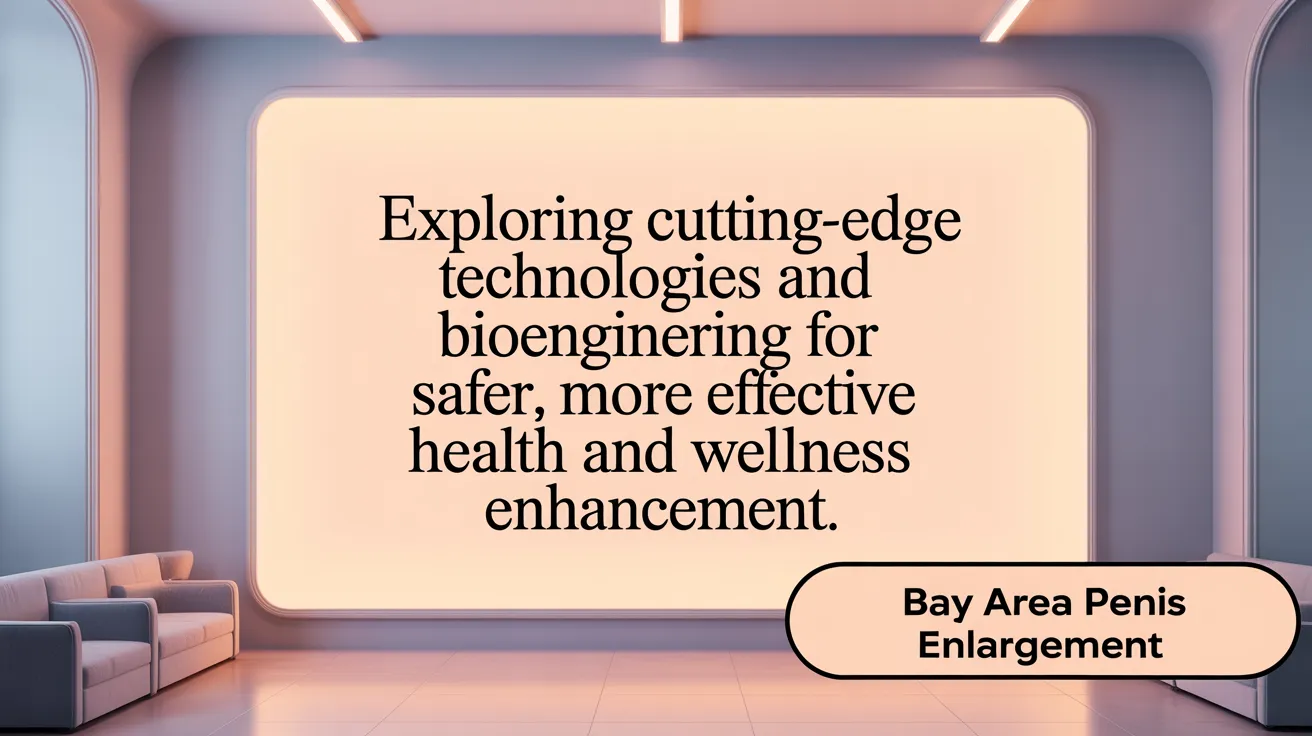A New Era in Male Enhancement
Non-surgical male enhancement has progressed from niche practices to scientifically backed, minimally invasive procedures offering men safer, more natural options to improve penile girth and length. Advances in injectable fillers, regenerative medicine, and emerging technologies are reshaping treatment paradigms, emphasizing safety, reversibility, and individualized care. This article explores these technological innovations transforming male enhancement today and glimpses into a future shaped by biotechnology and artificial intelligence.
Hyaluronic Acid Fillers: The Cornerstone of Non-Surgical Girth Enhancement
What is Hyaluronic Acid and How Does it Work?
Hyaluronic acid is a naturally occurring substance in the human body known for its ability to retain water and keep tissues hydrated and elastic. In non-surgical penile girth enhancement, hyaluronic acid works by binding water molecules within the penile tissue, thereby increasing volume and creating a fuller, natural appearance.
Key Products and Treatment Procedure
Leading products like UroFill™ and PhalloFILL® use hyaluronic acid as the primary agent to enhance penile circumference. These treatments are minimally invasive penile procedures and typically performed in-office under local anesthesia. The procedure time ranges from 30 to 60 minutes, during which the filler is carefully injected around the penile shaft to achieve uniform girth enhancement.
Outcomes and Patient Satisfaction
Following treatment, patients often see immediate results, with an average increase in girth around half an inch or more after initial sessions. The enhancement provides a natural look and feel, tailored to individual patient needs. Satisfaction rates are high, supported by the treatment’s efficacy and low complication profile as noted in studies on hyaluronic acid penile treatments.
Safety and Reversibility
One of the advantages of hyaluronic acid fillers is their reversibility. If needed, hyaluronidase can be injected to dissolve the filler safely. The safety profile is strong because the filler is biocompatible and minimally invasive, and the procedures are performed with attention to patient safety and low complication rates.
Downtime and Maintenance
Patients experience minimal downtime, with most resuming daily activities immediately and only refraining from sexual activity for about one week post-procedure. Results can last from 18 months to 2-4 years depending on the specific product used, such as PhalloFILL® or UroFill™. Touch-up treatments are available to sustain or enhance the results over time.
Regenerative Medicine: PRP and PRF Therapies for Natural Enhancement

What role do platelet-rich plasma (PRP) and platelet-rich fibrin (PRF) play in male enhancement?
Platelet-Rich Plasma (PRP) Therapy for Men and Platelet-Rich Fibrin (PRF) in penile treatments are innovative regenerative therapies that harness the patient's own blood components rich in growth factors. These substances stimulate tissue regeneration and enhance blood flow, encouraging collagen production in penile tissue. The result is a gradual and natural increase in penile size, including both length and girth, along with improved erectile function and sensitivity.
How are these therapies administered and what benefits do they offer?
These treatments are delivered through targeted injections into specific areas of the penis during outpatient procedures typically completed within a short clinic visit. The process involves drawing blood from the patient, preparing the PRP or PRF concentrates, and injecting them carefully to stimulate tissue expansion and repair. This approach is safe and minimally invasive penile treatment avoiding the risks and recovery time related to surgical interventions.
What treatment protocols and patient suitability considerations exist?
Candidates for PRP and PRF therapies are generally healthy men seeking natural improvements without surgery, especially those who want to enhance blood flow, sexual performance, and tissue quality. Protocols often include multiple sessions spaced over weeks or months, with minimal downtime and quick return to normal activities. Consultation and Treatment Process involves personalized treatment plans created to optimize outcomes based on individual health and goals.
What benefits do these therapies have compared to surgical methods?
Regenerative therapies like PRP and PRF avoid incisions, implants, and associated complications such as scarring or infection. They promote the body's natural healing mechanisms to improve function and appearance gradually. Patients experience enhanced sexual confidence, a natural feel, and minimal discomfort or side effects.
Are combination treatments with fillers common?
Yes, PRP and PRF are frequently combined with dermal fillers such as hyaluronic acid to address both internal tissue health and external girth enhancement. This synergy allows comprehensive enhancement by improving blood vessel growth and tissue regeneration internally, alongside immediate volume increases externally.
What do clinical experiences and outcomes reveal?
Many patients report improved erectile quality, increased sensitivity, and noticeable size enhancements over several weeks. Minimal adverse effects have been observed, and the natural regenerative process supports safe, effective, and sustainable results. Clinics specializing in regenerative medicine provide tailored care ensuring high patient satisfaction.
These advancements highlight a promising direction in non-surgical penile enhancement, focusing on safety, natural outcomes, and functional improvements.
Emerging Technologies: Laser, Ultrasound, and Bioengineering Innovations

What are some advanced technologies emerging in non-surgical male enhancement?
Cutting-edge technologies in male enhancement are expanding beyond traditional fillers and injections. Laser therapies and ultrasound techniques are now being applied to promote tissue regeneration and improve penile blood flow. These methods are minimally invasive, offering benefits such as reduced recovery time and fewer complications compared to surgical alternatives.
Tissue engineering is another promising area, employing biodegradable scaffolds to support steady tissue growth. This approach has demonstrated significant increases in penile girth with low complication rates, pointing to safer, long-term solutions.
Further advancing the field, 3D bio-printing technology enables the creation of customized implants and tissue constructs designed specifically for individual patient anatomy, enhancing both functionality and cosmetic outcomes.
How might AI and biotechnology influence future male enhancement treatments?
Artificial intelligence (AI) is poised to revolutionize male enhancement by providing predictive modeling based on a patient’s genetic profile and clinical data. This facilitates personalized treatment plans that improve effectiveness while minimizing risks.
Biotechnology innovations, such as bioengineered tissue and implantable devices created through 3D bio-printing, promise to offer tailored options that better integrate with the body's natural structures.
Together, these advancements signal a new era of regenerative and implantable devices that could deliver superior results with fewer side effects, greater safety, and higher patient satisfaction.
Psychological Impacts and Patient Satisfaction with Non-Surgical Treatments

What psychological outcomes do men experience after non-surgical penile girth enhancement?
Men undergoing non-surgical penile girth enhancement often report notable psychological benefits. Approximately 47% experience increased self-confidence, while about 42% report enhanced sexual pleasure. These improvements frequently coincide with a significant reduction in the perceived discrepancy between their actual and ideal penile size, even when their size is within the normal range. Despite these positive outcomes, some men continue to struggle with psychological distress, underscoring that concerns over penile size can extend beyond physical attributes to deeper body image issues.
What psychological factors motivate men to seek enhancement?
Many candidates for enhancement harbor dissatisfaction with their penile appearance, often influenced by societal and cultural standards. Psychological factors, including self-esteem challenges and the desire to conform to perceived ideals, play a significant role. Notably, some men may have underlying body dysmorphic disorder (BDD); reported prevalence before treatment is around 11%, though most cases do not persist after the procedure. For more on psychological factors in penile enlargement, see this detailed review.
What is the significance of psychological assessment before treatment?
Pre-treatment psychological assessment is critical to identifying mental health conditions like BDD and ensuring that patients hold realistic expectations. Proper screening can prevent dissatisfaction stemming from unrealistic goals and helps guide men toward appropriate treatment options. This approach tends to contribute to improved satisfaction and mental health outcomes post-procedure. Learn more about psychological assessment for augmentation candidates.
What complications and concerns are reported by patients?
While physical complications are typically minor in non-surgical treatments, some men express concerns related to aesthetic results or encounter issues that affect sexual activity. Such complications stress the importance of comprehensive counseling and a focus on both physical and psychological readiness before proceeding. For an overview of complications and safety in penile girth enhancement methods, please refer here.
Why is managing expectations important?
Managing expectations is essential for patient satisfaction. Since enlargement results do not guarantee a complete resolution of body image concerns, clear communication about achievable outcomes can reduce dissatisfaction and promote a healthy psychological adjustment to changes. Explore further on the importance of realistic expectations for penile girth augmentation.
Non-Surgical Lengthening Techniques: RegeneGro and Traction Devices
How does RegeneGro provide non-surgical penile lengthening?
RegeneGro is a non-surgical penile lengthening treatment that utilizes Platelet-Rich Plasma (PRP) derived from the patient's own blood. The procedure combines PRP injections with medications designed to boost blood flow and specialized tissue-stretching devices. This trio works synergistically to stimulate gradual tissue regeneration, blood vessel growth, and collagen production in penile tissue, ultimately promoting natural length and girth increases without incisions or implants.
What are the benefits and typical outcomes of RegeneGro treatment?
Patients undergoing RegeneGro can expect up to 1.3 inches of length gain and approximately 0.5 inches of increased girth over a six-month period. The procedure involves a consultation, blood draw, PRP preparation, and targeted injections, followed by the use of tissue-stretching products as part of a personalized penile enhancement treatment. Recovery time is minimal, with most men resuming daily activities on the same day. Regular follow-up ensures optimal results and helps monitor progress.
Are penile traction devices effective for lengthening?
Penile traction devices apply continuous, gentle stretching to penile tissue over several months. This mechanical tension can induce tissue expansion and remodeling, possibly resulting in modest but permanent length gains. Although effects vary among individuals, these devices are generally safe, with no serious adverse effects reported. Their success depends on consistent use over extended periods, often several hours daily for months. See Traction therapy for penile lengthening for detailed information.
Safety profiles and limitations
Both RegeneGro and penile traction devices are minimally invasive and carry low risks compared to surgical alternatives. RegeneGro leverages the body's natural healing mechanisms, reducing complications. Traction devices have a good safety track record but require patient compliance. However, gains from traction devices tend to be smaller and progress slower than PRP-based therapies. Individual results vary, and consultation with a medical professional is essential to determine the best approach. For additional context, refer to Safety of natural substance treatments and Non-surgical penile enhancement options.
Innovations in Penile Prostheses and Implantable Devices

What advances have been made in penile prostheses for enhancement?
Recent advances in penile prostheses emphasize both aesthetic and functional improvement. The Penuma® implant stands out as an FDA-cleared subcutaneous silicone device designed to enhance girth and length in men with normal erectile function but dissatisfaction with their penis appearance. This outpatient procedure typically lasts about 45 minutes and utilizes local or general anesthesia.
Emerging technologies include prostheses that integrate electronic controls and shape-memory alloy materials. These innovations aim to mimic natural erections more closely, reduce surgical risks, and improve the patient experience by offering devices that can alternate between flaccid and erect states, controlled externally.
How do these surgical implants compare with non-surgical options?
Surgical implants like Penuma® provide more permanent and significant enhancements in penile size but come with typical surgical considerations such as recovery time and potential complications including infection and capsular contracture. However, newer techniques have reduced infection rates to approximately 2-3% (Infection and scarring risks).
In contrast, non-surgical methods (e.g., hyaluronic acid fillers, PRP injections, minimally invasive penile girth treatments) are gaining popularity due to their safety, minimal downtime, reversibility, and natural results. These minimally invasive procedures typically require maintenance or repeated treatments to sustain results, offering flexibility at the cost of durability.
Minimizing Recovery Time and Improving Aesthetics
Innovations such as the tunica expansion technique (TEP) allow for penile length and girth enhancement with reduced scarring and recovery periods by utilizing small, precise incisions through a single scrotal approach. Local nerve blocks facilitate pain management without narcotics, improving patient comfort.
Integration with Non-Surgical Treatments
Combining surgical implants with non-surgical therapies like shockwave therapy and regenerative injections may optimize therapeutic outcomes. This integrated approach could help enhance tissue health, improve erectile function, and maintain implant results, reflecting the trend toward personalized treatment plans.
| Aspect | Surgical Implants (e.g., Penuma®) | Non-Surgical Treatments | Notes |
|---|---|---|---|
| Procedure Type | Outpatient surgery (approx. 45 minutes) | In-office injections or therapies | Surgery involves anesthesia; non-surgery uses local anesthesia |
| Recovery Time | Days to weeks, with discharge same day | Minimal downtime; return to activities quickly | Non-surgical favored for rapid recovery |
| Longevity of Results | More permanent, durable enhancements | Temporary, lasting months to a few years | Maintenance/repeat treatments needed for non-surgical methods |
| Safety Profile | Low complication rates (infection ~2-3%) | Very low risk, reversible treatments | Surgical risks exist but have been minimized |
| Technological Innovations | Electronic prostheses, shape-memory alloys | PRP, dermal fillers, shockwave therapy | Future focus on hybrid personalized treatments |
These advances highlight the growing spectrum of options for penile enhancement, allowing men to choose approaches best suited to their needs and preferences.
Safety Considerations and Complication Management in Non-Surgical Procedures

What are the primary safety concerns with non-surgical penile enhancement injections?
Non-surgical penile enhancement using injectables, especially hyaluronic acid (HA) fillers, can lead to several short-term complications. Common issues include penile edema (swelling), hypersensitivity reactions, erythema (redness), and the formation of subcutaneous nodules. Nodule formation is the most frequently reported complication, typically appearing about two weeks after injection. Infection, while rare, is a serious concern and may present with pain, redness, and swelling. Prompt diagnosis, often supported by imaging such as CT scans, is critical to prevent severe damage or loss of function.
How are potential complications minimized?
Minimizing complications starts with utilizing qualified and experienced providers who perform these procedures under sterile conditions. Proper patient selection is essential, avoiding those with active penile inflammatory conditions or allergies to fillers. Advanced techniques, including ultrasound guidance for precise botulinum and other injectable placements, can improve safety and reduce side effects. Post-procedure care instructions such as temporary restrictions on sexual activity also play a significant role in recovery. Treatments such as hyaluronidase can effectively dissolve HA nodules if they occur, while antibiotics and surgical intervention may be required for infections.
Are there standardized clinical guidelines for these procedures?
Currently, there is an absence of standardized clinical guidelines for non-surgical penile enhancement injections. Although hyaluronic acid fillers show a good safety profile and high patient satisfaction, the evidence base consists mainly of observational studies with some reports of disabling complications. This underscores the need for further high-quality randomized controlled trials to establish comprehensive guidelines, optimal injection techniques, and safety protocols for these treatments.
Adverse Effects from Botulinum Toxin and Other Injectables
Injectable treatments such as botulinum toxin can cause side effects like bruising, pain, swelling, or temporary complications such as priapism and dizziness. These effects are mostly transient but require monitoring. The use of ultrasound guidance enhances injection accuracy, which helps minimize risks.
Importance of Qualified Providers and Technique
Ensuring that non-surgical penile enhancement procedures are performed by board-certified urologists or similarly qualified specialists using established protocols significantly reduces adverse outcomes. Meticulous technique, proper dosing, and patient counseling about realistic expectations contribute to safer and more satisfactory results.
| Concern Area | Typical Manifestations | Management Strategies |
|---|---|---|
| Hyaluronic acid nodules | Subcutaneous lumps ~2 weeks post-injection | Hyaluronidase enzyme, surgery |
| Infection | Pain, redness, swelling | Antibiotics, imaging, surgery |
| Edema & hypersensitivity | Swelling, redness, irritation | Supportive care, medications |
| Botulinum side effects | Bruising, priapism, dizziness | Monitoring, ultrasound-guided injection |
Looking Ahead: The Future of Non-Surgical Male Enhancement
Technological advances have revolutionized non-surgical male enhancement, offering men safer, effective options to improve penile girth and length without the risks of surgery. Hyaluronic acid fillers and regenerative therapies like PRP have become mainstays due to their natural results, safety, and minimal downtime. Emerging innovations in laser, ultrasound, tissue engineering, and AI-guided personalized treatments promise to further enhance outcomes and customization. While surgical implants remain an option for permanent enhancement, non-surgical techniques increasingly satisfy patient demand with fewer complications. However, comprehensive safety protocols and standardized guidelines are needed to optimize these treatments as research progresses. Ultimately, integrating cutting-edge technology and psychological care will ensure that male enhancement evolves as a holistic, patient-centered practice.

